Arden Vienna Youth Mask
In 1928, Elizabeth Arden announced a new facial treatment available in her New York salon advertised as the Vienna Youth Mask. It used a well-established medical procedure generally referred to today as ‘medical diathermy’. Arden had already introduced the mask in London and Paris in 1927.
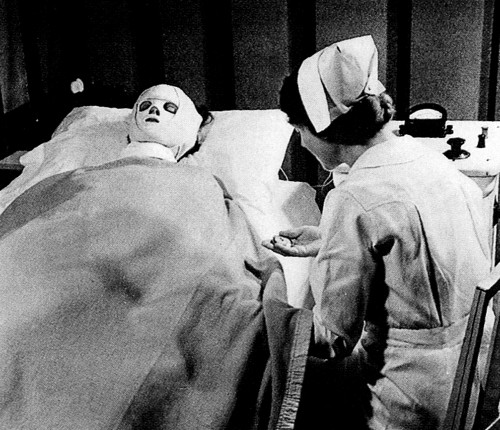
Above: 1937 Elizabeth Arden Vienna Youth Mask administered by a nurse trained in diathermy. The mask was made of papier-mâché lined with tinfoil that was moulded to the client’s face. Early masks appear to have been made from plaster of Paris rather than papier-mâché. In Elizabeth Arden’s New York salon, clients paid US$200 for course of 32 treatments.
See also: Elizabeth Arden (1920-1930)
Elizabeth Arden’s Vienna Youth Mask used diathermy to warm up the facial tissues of clients so, like other beauty treatments – such as massage, patters and circulation creams – its primary effect was to stimulate blood circulation.
Elizabeth Arden’s genius is again emphasised by the introduction of the Vienna Youth Mask treatment. It really does firm and rejuvenate the facial tissues, and among its other advantages is that no operation of any kind is required. It does not effect a sudden and almost startling transformation in the appearance, but it brings a steady improvement which is noticed after the first few treatments. Almost immediately the skin becomes firmer and clearer, and the circulation is so improved that it becomes quite unnecesssary to use rouge. At the first sitting a mask is made of the client’s face, and from this a special mask is prepared which is used at the subsequent visits. Each treatment, which is given under the supervision of a highly-trained attendant, is followed by a muscle-strapping one. Furthermore the process is a natural one, and the results are not merely temporary, nor is there any fear of the muscles becoming quickly relaxed again.
(Elizabeth Arden advertorial, 1927)
See also: Patters and Circulation Creams
However, there is more to the Vienna Youth Mask than this; as mentioned in a 1935 profile of Elizabeth Arden published in ‘The New Yorker’, the Vienna Youth Mask had links to other rejuvenation therapies that created a lot of interest in the 1920s.
The Vienna Youth Mask, perhaps more than any other Arden creation, represents the accommodation of science to the beauty business. Arden thought it up ten years ago, in Vienna, when she heard Professor Steinach talk about diathermy—the application of heat to tissues in the body by means of electrical current—and the benefits derived from it by soldiers whose muscles and nerves had been injured in the World War. Physicians for some thirty years have used this method in treating arthritis and other inflammatory conditions, but it took Elizabeth Arden to turn it into a beauty treatment. With one Dr. Last of Vienna, she invented the Youth Mask, a device made of papier-mâché and lined with tinfoil, which is fitted over the client’s face and connected by conducting cords to a diathermy machine. Arden’s belief is that electricity so replenishes the cells in a woman’s face, which, she says, die first under the eyes, and next under the chin. Medicine offers no corroboration for the Arden theory; diathermy does stimulate circulation, but it cannot restore dead cells.
(Harriman, 1935, p. 24)
Diathermy and rejuvenation
In 1918, after working on animals for many years, Eugen Steinach used vasoligation and/or vasectomy of the testes to ‘restore the youth and vitality’ of a human subject, arguing that his procedure triggered the proliferation of hormone-secreting cells in the testes and rejuvenated the individual. Steinach was not a surgeon so his operations was carried out by the urologist Dr. Robert Lichtenstern [1874-1952]. The procedure was adopted by other medical practitioners and similar operations were carried out on men around the world.
See also: Rubinstein and the Rejuvenationists
Experiments were also conducted on women as a rejuvenation treatment for menopause. Initially, women had their ovaries treated with low doses of X-rays, supposedly the female equivalent of the testicular vasoligation or vasectomy. Dr. Last, a colleague of Steinach, who worked on female rejuvenation, switched from X-rays to heating the ovaries with a diathermy machine. It was this Dr. Last that Arden hired to develop the apparatus she used for the Vienna Youth Mask.
Elizabeth Arden was not expecting her Vienna Youth Mask to have a similar ‘rejuvenating effect’ on skin cells that diathermy treatments had on ovarian tissue. As mentioned earlier, she explained that it worked by increasing the blood circulating through the skin.
The Vienna Youth Mask stimulates the circulation, producing health as Nature herself does, through a constantly renewed blood supply.
The amazing value of this treatment lies in the depth to which it penetrates, causing the blood to flow in a rich purifying stream to underlying tissues and muscles . . . charging them with new youth and vigor. It stirs the circulation as no external friction or massage can possible do.
Concentrated on the face and neck, as the treatment is given in Miss Arden’s Salons, it is as though electric energy were poured into your very veins. Fresh blood flushes the surface, carrying away impurities. The skin is cleared and brightened. Best of all, there comes an exuberant, glad-to-be-alive feeling, a freedom from fatigue that is the true measure of health.(Elizabeth Arden advertisement, 1930)
This was also suggested by Helena Rubinstein when she introduced her Monoval Masque (1935) aimed at clients with relaxed muscles, soft tissues, and withered and devitalized skin. This also used diathermy which Rubinstein claimed “acted deeply on the circulation, bringing the blood into the tissues, renewing the cells, and causing a general rejuvenation of the whole organism” (Rubinstein advertisement, 1935).
See also: Diathermy
Arden abandoned the Vienna Youth Mask in 1938, replacing it with another diathermic treatment, the Intra-Cellular Mask.
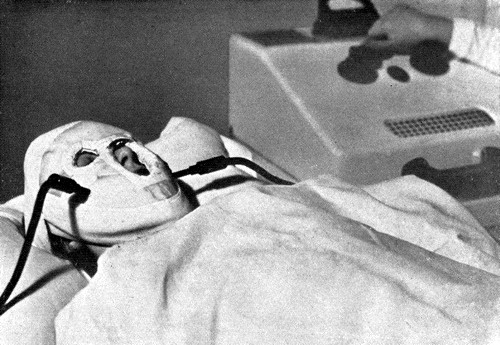
Above: 1939 Elizabeth Arden Intra-Cellular Mask.
Elizabeth Arden maintains that there is no face so lost to beauty that it cannot be transformed, revivified, remodelled. To this end, she has now created, with the aid of a continental specialist in electro-therapy, the INTRA-CELLULAR MASK. It is designed to promote the health of the actual cells which comprise the tissues of the face by means of a new method of adapting micro-waves to this particular purpose, and is an outstanding achievement. For women over thirty, for women whose tissues have become depleted through illness or worry whatever their age, the Intra-Cellular Mask treatments are invaluable. … The treatment is always given by a graduate nurse, trained especially in electro-therapy work. It is followed by Miss Arden’s Muscle Strapping treatment and proper make-up, which are included in the price of the complete course.
(Arden advertisement, 1938)
The reason for the switch to the Intra-Cellular Mask in 1938 may be simple. In that year the Food, Drug and Cosmetic Act (FD&CA) was passed in the United States and Arden may have reasoned that officials from the American Food and Drug Administration (FDA) – charged with administering the Act – would not look kindly on a treatment that used either ‘Vienna’ or ‘Youth’ in its name; the Intra-Cellular Mask would be less likely to produce regulatory problems.
Updated: 26th November 2018
Sources
Cumberbatch, E. P. (1937). Diathermy including diathermotherapy and other forms of medical and surgical electrothermic treatment (3rd ed.). Great Britain: William Heinemann (Medical Books) Ltd.
Harriman, M. C. (1935). Glamour, Inc. The New Yorker, April 4, 24-30.
Miller, N. L., & Fulmer, B. R. (2007). Injection, ligation and transplantation: The search for the glandular fountain of youth. The Journal of Urology. 177(6), 2000-2005.
Trimmer, E. J. (1967). Rejuvenation. The history of an idea. London: The Scientific Book Club.
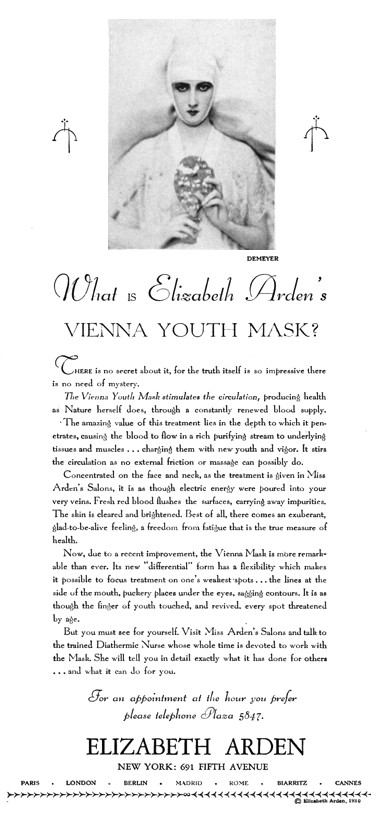
1930 Elizabeth Arden Vienna Youth Mask.
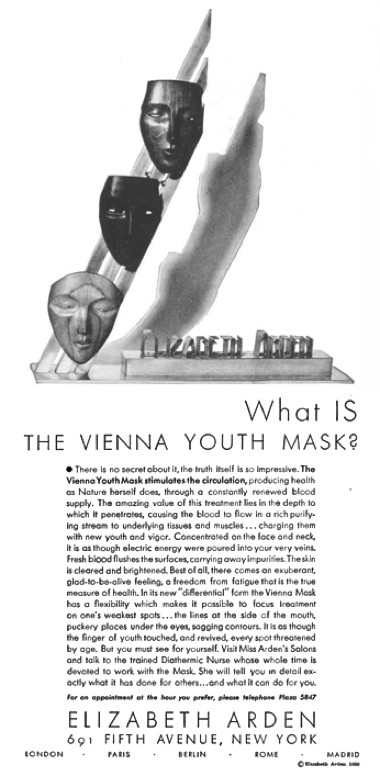
1930 Elizabeth Arden Vienna Youth Mask.
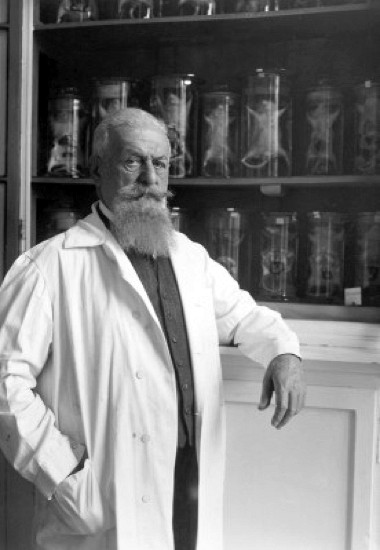
Eugen Steinach [1861-1944].
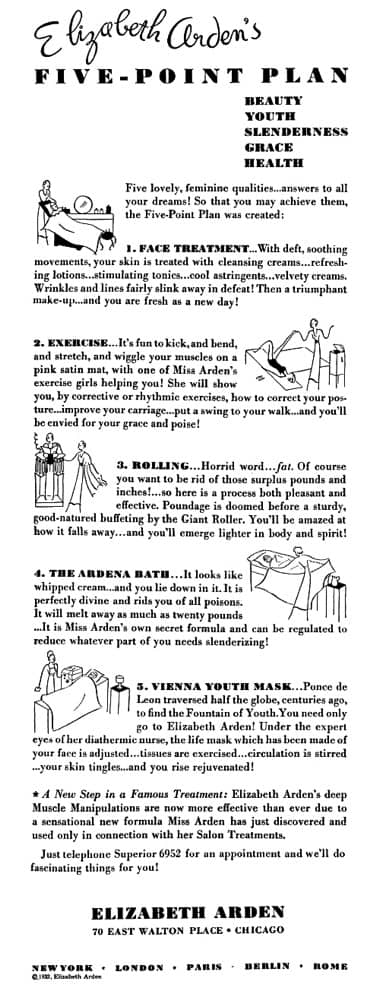
1933 Elizabeth Arden Five-Point Plan incorporating the Vienna Youth Mask.
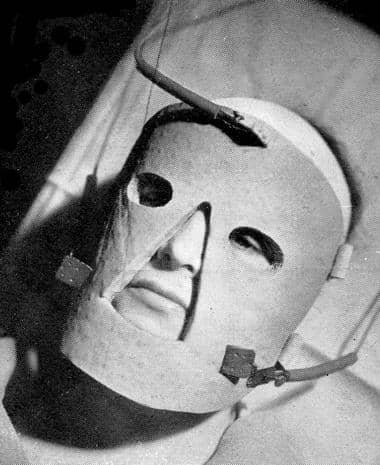
1935 Helena Rubinstein Monoval Masque. The radiotherapy ‘regenerates the relaxed tissues and muscles. Provides a general rejuvenation of the whole organism’.
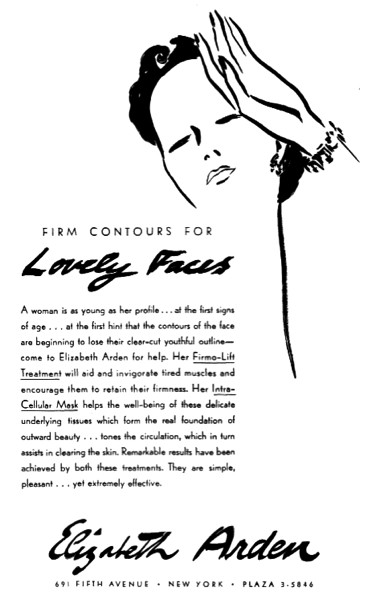
1938 Elizabeth Arden Firmo-Lift and Intra-Cellular Mask.
